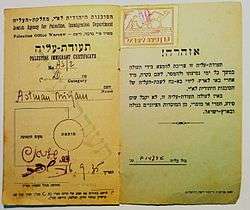Fifth Aliyah
| Part of a series on |
| Aliyah |
|---|
 |
| Jewish immigration to the Land of Israel |
| Concepts |
| Pre-Modern Aliyah |
| Aliyah in modern times |
| Absorption |
| Organizations |
| Related topics |
The Fifth Aliyah (Hebrew: העלייה החמישית, HaAliyah HaHamishit) refers to the fifth wave of the Jewish immigration to Palestine from Europe and Asia between the years 1929 and 1939,[1] with the arrival of 225,000 to 300,000 Jews.[2] The Fifth immigration wave began after the 1929 Palestine riots, and after the comeback from the economic crisis in Mandatory Palestine in 1927, during the period of the Fourth Aliyah. The end of this immigration wave was with the start of World War II.
This wave of immigration began as a pioneering one, but with the onset of racial persecution in Nazi Germany attained the character of a mass migration between 1933 and 1939, with at least 55,000 Jews from Central Europe immigrating to Palestine or residing there as semi-permanent residents.[3] The riots in the British Mandate during 1936 had weakened the immigration wave, but during the years 1938-1939 thousands of immigrants came, some of them illegally.
The causes for the Immigration
- The rise to power of Hitler and the Nazi Party caused enormous disruption to the lives of Jews in Germany and Eastern Europe. As Nazi persecution tightened its grip on the Jewish population, many who wished to leave Germany were prevented by the immigration laws of the Third Reich, forcing them to stay and suffer from the titanic wave of overt antisemitism sweeping the country. In an attempt to ameliorate this problem, a transmission agreement (Haavara) was reached in August 1933 between the Jewish agency and the Nazi authorities, stipulating that Jews leaving Germany be reimbursed for their assets, even though German law at that time required Jews to give up their assets in order to leave. In addition to these provisions, an allowance was also made for the importation of German merchandise to Palestine. While not destined to be a permanent arrangement, the Haavara Agreement served interests on both sides of the dispute and helped facilitate continued Jewish immigration to the region.
- The exchange of the British colonial administrator - the new British colonial administrator, Arthur Wauchope, was pro-Zionist, granting many immigration permits and encouraging the Jewish economy and Zionist settlement.
- The economic growth in Palestine - the transmission agreement with Germany bringing large amounts of money was a starting point to the recovery of the Jewish economy in Palestine after the crisis of the late 1920s.
- The closing of gates to the United States - in 1921 the United States decided to condense immigration, and even during the period of the Fifth Aliyah the US kept its gates closed to the majority of immigrants, despite the persecution of the Jews in Europe.
- Anti-semitism in the world prevailed - many more regimes in mainly European countries adopted a policy of anti-semitism which encouraged riots, persecution and the economic and social limitations on Jews.
Gallery
 Palestine immigrant certificate issued in Warsaw (16-9-1935) by the Jewish Agency
Palestine immigrant certificate issued in Warsaw (16-9-1935) by the Jewish Agency Immigrants from Germany arriving to the Jaffa port in 1933
Immigrants from Germany arriving to the Jaffa port in 1933
References
- ↑ Israeli government site on the Fifth Aliyah
- ↑ Yoav Gelber, "The Historical Role of Central European Immigration to Israel," Leo Baeck Institute Year Book 38 (1993), p. 327.
- ↑ Yoav Gelber, "The Historical Role of Central European Immigration to Israel," Leo Baeck Institute Year Book 38 (1993), p. 326 n. 6.
| Wikimedia Commons has media related to Fifth Aliyah. |